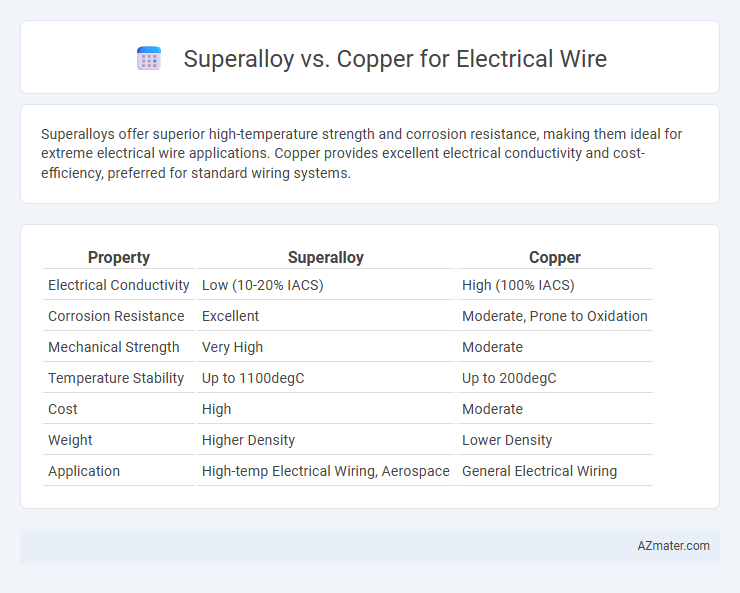Superalloys offer superior high-temperature strength and corrosion resistance, making them ideal for extreme electrical wire applications. Copper provides excellent electrical conductivity and cost-efficiency, preferred for standard wiring systems.
Table of Comparison
| Property | Superalloy | Copper |
|---|---|---|
| Electrical Conductivity | Low (10-20% IACS) | High (100% IACS) |
| Corrosion Resistance | Excellent | Moderate, Prone to Oxidation |
| Mechanical Strength | Very High | Moderate |
| Temperature Stability | Up to 1100degC | Up to 200degC |
| Cost | High | Moderate |
| Weight | Higher Density | Lower Density |
| Application | High-temp Electrical Wiring, Aerospace | General Electrical Wiring |
Introduction to Superalloys and Copper in Electrical Wiring
Superalloys, composed primarily of nickel, cobalt, or iron, offer exceptional strength, corrosion resistance, and thermal stability, making them suitable for high-performance electrical wiring in extreme environments. Copper, known for its superior electrical conductivity and ductility, remains the standard choice for most electrical wiring applications due to efficient current transfer and ease of installation. The comparison between superalloys and copper centers on balancing conductivity with mechanical properties for specific wiring requirements.
Material Composition and Properties
Superalloys, primarily composed of nickel, cobalt, and iron with added elements like chromium and molybdenum, exhibit exceptional mechanical strength, corrosion resistance, and high-temperature stability, making them suitable for harsh electrical environments. Copper, consisting almost entirely of pure copper, offers excellent electrical conductivity, superior thermal conductivity, and good ductility, which are critical for efficient electrical wire performance but lacks the high-temperature and corrosion resistance found in superalloys. The choice between superalloy and copper wiring depends on application requirements balancing conductivity, durability, and environmental factors.
Electrical Conductivity Comparison
Copper exhibits significantly higher electrical conductivity than superalloys, with copper's conductivity around 59.6 million siemens per meter (MS/m) compared to superalloys typically below 10 MS/m. This pronounced difference makes copper the preferred choice for electrical wiring where low resistance and efficient current flow are critical. Superalloys, despite their superior mechanical strength and corrosion resistance, cannot match copper's performance in electrical conductivity applications.
Thermal Stability and Heat Resistance
Superalloys exhibit superior thermal stability and heat resistance compared to copper, maintaining mechanical strength and conductivity at temperatures exceeding 700degC, while copper tends to soften and lose conductivity above 400degC. The enhanced oxidation resistance and creep strength of superalloys make them ideal for high-temperature electrical wire applications in aerospace and industrial environments. Copper remains preferred for standard wiring due to its excellent electrical conductivity and lower cost but is limited by its thermal performance under extreme conditions.
Mechanical Strength and Durability
Superalloys exhibit superior mechanical strength and durability compared to copper, making them ideal for high-stress electrical wire applications in extreme environments. The high tensile strength and resistance to creep and fatigue of superalloys ensure longevity under thermal and mechanical loads, unlike copper which, despite excellent electrical conductivity, tends to deform and oxidize more readily. This makes superalloys a preferred choice for aerospace and industrial wiring where durability and reliability are critical.
Corrosion Resistance and Longevity
Superalloys exhibit superior corrosion resistance compared to copper, making them ideal for electrical wires used in harsh or high-temperature environments where oxidation and chemical degradation are critical concerns. The enhanced longevity of superalloy wires stems from their ability to maintain structural integrity and conductivity over extended periods despite exposure to corrosive elements. Copper, while highly conductive, is more susceptible to corrosion and often requires protective coatings to achieve comparable durability in aggressive conditions.
Weight and Flexibility Considerations
Superalloys offer high strength and corrosion resistance but are significantly heavier compared to copper, impacting overall wire weight in applications where minimal mass is crucial. Copper excels in flexibility due to its ductility, making it ideal for winding and bending in complex electrical wiring systems, whereas superalloys tend to be more rigid and less accommodating to repeated flexing. Prioritizing copper ensures lightweight, highly flexible wiring solutions, while superalloys may suit scenarios demanding extreme durability and temperature resistance despite increased weight and reduced flexibility.
Cost and Economic Factors
Superalloy electrical wires typically have higher material and manufacturing costs compared to copper due to their complex alloy composition and specialized processing requirements. Copper remains the cost-effective choice for most electrical wiring applications because of its excellent conductivity and widespread availability, leading to lower raw material costs and easier installation. However, superalloys may offer economic benefits in high-temperature or corrosive environments by reducing maintenance and replacement expenses over the wire's lifecycle.
Applications and Use Cases in Industry
Superalloys are primarily used in high-temperature electrical wire applications such as aerospace and power generation due to their exceptional thermal stability and resistance to oxidation, enabling reliable performance in harsh environments. Copper remains the dominant choice for general electrical wiring in residential, commercial, and industrial sectors because of its superior electrical conductivity, ductility, and cost-effectiveness. Specialized industries leverage superalloy wires for high-strength, corrosion-resistant components in turbine engines and electrical connectors, while copper wiring is preferred for efficient power transmission and distribution systems.
Future Trends in Electrical Wiring Materials
Superalloys are gaining traction in electrical wiring due to their superior high-temperature resistance and mechanical strength compared to copper, which remains favored for its excellent electrical conductivity and cost-effectiveness. Emerging trends highlight the development of hybrid wiring systems that combine superalloy cores with copper coatings to optimize durability and performance in extreme environments, particularly in aerospace and renewable energy sectors. Advanced research into nanostructured superalloys aims to enhance conductivity while maintaining corrosion resistance, signaling a shift toward materials that can withstand harsher operating conditions in future electrical infrastructure.

Infographic: Superalloy vs Copper for Electrical Wire
 azmater.com
azmater.com